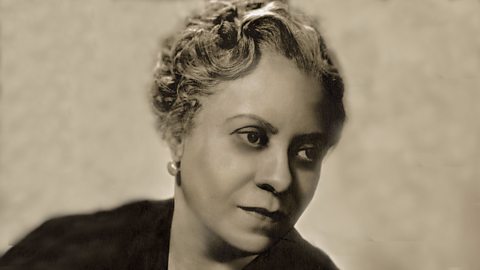Dates: b. 1887 / d. 1953
Nationality: American
Period: 20th Century
Genre: Symphony
Key Musical Elements:
- Duration
- Meter
- Rhythm

Why is she a Trailblazer?
As an African-American woman, Florence Price combined the traditions of classical music with the sound of spirituals and West African rhythms and dance from her own culture.
In 1933 she overcame prejudice to become the first black female composer to have her work performed by a major orchestra.
Listen out for:
The rhythms in this music originated in West Africa. Florence Price took the traditions of classical music and combined them with West African rhythms and dance. In the orchestra these rhythms are played in the percussion section and are mirrored in other sections of the orchestra.
Naomi Wilkinson explores the West African rhythms of Florence Price’s Symphony No. 1. Price combines these rhythms with the sound of spirituals and traditional classical music.
Fast Facts
Florence Price’s mother was a music teacher and encouraged young Florence to learn the piano.
After attending the New England Conservatory of Music, one of the few institutions at the time to admit African Americans, Price taught music in Atlanta.
With racial tensions rising, Price and her family moved to Chicago where she found the music scene very stimulating. After getting divorced, Price played the organ for silent movies to support herself while she began composing in earnest.
Winning a composing competition, Price had her first symphony played by the Chicago Symphony Orchestra and her reputation began to grow. Although she wrote over 300 pieces of music, after her death Price’s work was largely forgotten. Today her work is being rediscovered and performed by many more orchestras again.
Watch the full performance of Price‚Äôs piece by the ≥…»ÀøÏ ÷ Scottish Symphony Orchestra, conducted by Roderick Cox.
Juba Dance
The ‘Juba Dance’ originates in West Africa and was brought over to the United States by slaves who were forced to work on plantations.
Banned from playing musical instruments, these slaves used their bodies to create music instead.
They created repeating percussive rhythms by patting and slapping their arms, legs and chest and stamping with their feet.
This kind of body percussion forms the basis of the Juba Dance that inspired the third movement of Florence Price’s Symphony No.1 in E minor. African drums echo the patting, slapping rhythms as the strings play an upbeat melody.
Price fused two worlds, taking a part of her own musical heritage and reimagining it with a classical orchestra.
Resources
KS2 Lesson plans
Explore and download lesson plans for six weeks of learning and activities for Symphony No. 1 in E minor by Florence Price.

Explore and download powerpoint slides for six weeks of learning and activities for Florence Price – Symphony No. 1 in E minor (3rd mvt) by Florence Price.

Download the audio version.

Downloadable .zip file containing arrangement and Price files.

Where next?
Try out some more body percussion of your own in Anna Meredith’s brilliant Connect It.
Or get moving to another kind of dance – the Mambo – in Leonard Bernstein’s lively piece.
Get creative and upload your responses using the Ten Pieces Uploader!
Upload and showcase your creative responses
Upload your creative responses to the Ten Pieces repertoire for your chance to feature in the Ten Pieces creative showcase.
